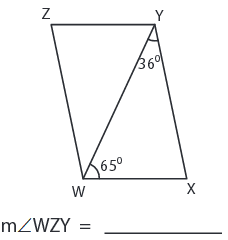HOW TO FIND THE ANGLES OF A PARALLELOGRAM
Subscribe to our ▶️ YouTube channel 🔴 for the latest videos, updates, and tips.
Definition of parallelogram :
A parallelogram is a quadrilateral which has opposite sides parallel.
Properties of parallelogram :
- Opposite angles are equal in size.
- Consecutive interior angles add upto 180.
- Vertical angles are a pair of non-adjacent angles formed by the intersection of two straight lines and are opposite to each other.
Find the measures of the indicated angles in each parallelogram.
Problem 1 :

Solution :
The sum of the interior angles of a triangle is 180°.
∠KML = ∠MKJ = 30°
∠KML + ∠JLM + 115° = 180°
∠JLM + 30° + 115° = 180°
∠JLM = 180° - 115° - 30°
∠JLM = 35°
Problem 2 :

Solution :
DC II AB
∠DCA = ∠BAC = 23°
∠BCD = ∠ACB + ∠DCA
∠BCD = 23° + 37°
∠BCD = 60°
Problem 3 :

Solution :
The opposite angles are equal in a parallelogram.
∠FHG = ∠HFE = 77°
So, ∠FHG = 77°
Problem 4 :

Solution :
The opposite angles are equal in a parallelogram.
∠WZY = ∠WXY
The sum of the interior angles of a triangle is 180°.
∠WXY = 180° - ∠XWY - ∠WYX
∠WZY = = 180° - 65° - 36°
∠WZY = = 79°
∠WZY = 79°
Problem 5:

Solution :
The sum of the interior angles of a triangle is 180°.
∠SQP = 180° - (113 + 22)
∠SQP = 180° - 135°
∠SQP = 45°
Problem 6:

Solution :
∠VUT = ∠SUV + ∠SUT
∠VUT = 28° + 52°
∠VUT = 80°
Problem 6 :

Solution :
In MNKL, ML II NK
So, ∠LNK = ∠NLM
∠MOL = ∠KON = 57° (vertical angles are equal)
∠LNK = 180° - ∠OML - ∠MOL
∠LNK = 180° - 99° - 57°
∠LNK = 24°
In ∆OMN,
∠NOK = ∠LNM + ∠OMN
∠OMN = ∠NOK - ∠LNM
∠OMN = 57° - 15°
∠OMN = 42°
The outside angle of a triangle is equal to the sum of two interior angles that are not adjacent to it.
NM II KL,
So, ∠MKL = ∠NMK = 42°
Problem 7 :

Solution :
∠XUV = ∠XWV = 96°
∠VXU = 180° - ∠XWV - ∠XVU
∠VXU = 180° - 96° - 22°
∠VXU = 62°
∠WVX = ∠VXU = 62°
Problem 8 :

Solution :
BE II DC,
∠EBD = ∠BDC = 21°
∠DOC = 180° - (∠BDC + ∠DCE)
∠DOC = 180° - (21 + 23)
∠DOC = 180° - 44°
∠DOC = 136°
ED II BC,
∠DEC = ∠ECB = 75°
∠DBC = ∠DOC - ∠ECB
∠DBC = 136° - 75°
∠DBC = 61°
∠ECD = ∠BEC = 23°
∠BED = ∠BEC + ∠DEC
∠BED = 23° + 75°
∠BED = 98°
Subscribe to our ▶️ YouTube channel 🔴 for the latest videos, updates, and tips.
Recent Articles
-
Finding Range of Values Inequality Problems
May 21, 24 08:51 PM
Finding Range of Values Inequality Problems -
Solving Two Step Inequality Word Problems
May 21, 24 08:51 AM
Solving Two Step Inequality Word Problems -
Exponential Function Context and Data Modeling
May 20, 24 10:45 PM
Exponential Function Context and Data Modeling